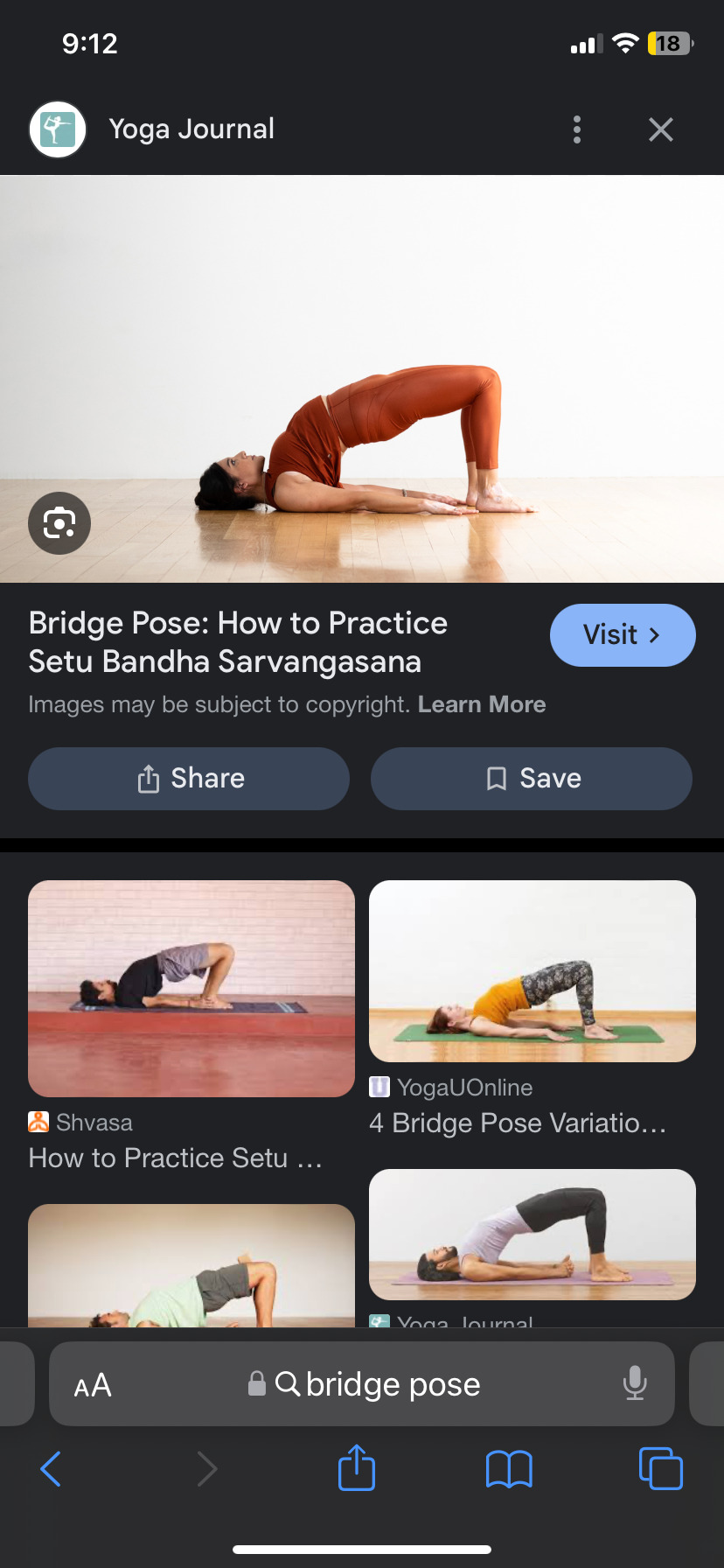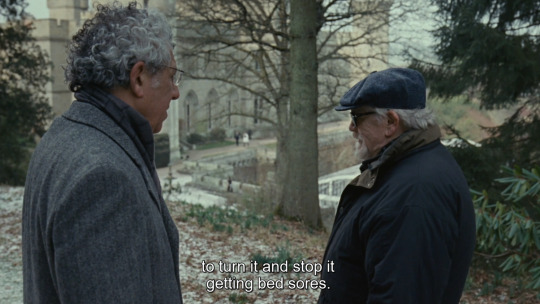#yoga problems
Explore tagged Tumblr posts
Text
Not Really
Autumn Beauty from Sharp Top Original 20″ x 16″ oil painting $640 Wall Prints and Prints on other items available with the link https://kendall-kessler.pixels.com/featured/autumn-beauty-from-sharp-top-kendall-kessler.html Our Yoga teacher said she had a more relaxing session planned for today. Yikes! I really can’t sit on my heels for a long time. I thought it was a tough session but I kept…

View On WordPress
#beach houses paintings#Blue Ridge paintings#fall paintings#gazebo paintings#Kendall Kessler Art#pawleys island paintings#Peaks of Otter paintings#Towhee Hill Studio Art#tree and wildflower paintings#yoga problems
0 notes
Text
It's damaging to be constantly on the hook to explain why we aren't getting better right away. And it's demoralizing to be thought of as "not trying hard enough."
...no one has thought as much about how we can get relief as we have. No one is more attuned to what might make life less miserable. No one has been more possessed to find promising treatments than we are...
What we really want is to be listened to and, most of all, to be understood.
from Why Chronic Pain Sufferers Hate Yoga by Randall H. Duckett (Medium)
#for the able bodied people#have you tried yoga#chronic pain#fibromyalgia#chronic illness#chronic fatigue#disability#fibro problems#fuck fibro
103 notes
·
View notes
Text
Just a reminder to be kind to yourselves today and everyday.
Take care of yourself as if you would an ill loved one. You deserve that cozy blanket, with the good show, a hot bath and that warm cup of tea.
Be kind to your body and what love it can manage to give you today and what love you can manage to give it.
Yoga is a wonderful option for some pain relief with Fibromyalgia and chronic pain in general. Yoga can help release tension from cramped up and tense muscles. Yoga is also a great stress buster and helps to reduce those feelings and effectively relax our nervous system. If you’re like me, high intensity workouts hurt me more than help me - being able to ease into each yoga pose slowly and be able to hold it for as long as it feels good for you and your body helps you feel both relaxed in your muscles and energized in your mind.
I like to curate a morning and evening yoga routine with the few practices I keep in my back pocket for those extremely high pain days.
Here’s a few yoga poses I suggest to help release some of that fibromyalgia tension and pain most of us experience:
1. Childs Pose - This asana helps to calm the mind.
It also gives a good stretch to the arms, shoulders, back, and hips.
2. Legs up the wall pose - By taking the weight off your feet, this pose helps relax the muscles of the hips and legs.
It relieves you of fatigue, a major symptom of fibromyalgia.
3. Cobra Pose - This pose helps flex the upper and middle back, another main affected area in fibromyalgia.
It also helps strengthen the arm muscles.
It helps improve blood circulation to various parts of the body.
It reduces fatigue; you feel deeply relaxed as you open up your shoulders and chest.
4. Bridge pose - This gives you a deep stretch to your back and wards off fatigue.
It also helps calm the nervous system so you feel less anxious.
It strengthens the back muscles, a possible tender point in those suffering from fibromyalgia.
5. Corpse Pose - It calms the mind and reduces both stress and fatigue.
It relieves headaches and sundry pains.
It helps you sleep better at night.
It may take you some time to get adjusted to these poses and how they feel for you but I advise to at least try them once, once a day, even just for 30 seconds. You’ve got this and most importantly…always listen to what your body needs from you. There’s no shame in having to adjust for ourselves and what we need to feel better in our bodies. Take care everyone 🦋
Ps. I posted some photos of each pose in the comments from google..each picture has the name of the pose underneath it. 🪬 and I also included a photo of my adorable yoga partner, my doodle who loves to join me on my mat everyday.
Think of those things we are grateful for❤️






#fibromyalgia#naturopathy#yogaposes#fibro problems#fibropain#fibroscan#yoga for fibromyalgia#yogadaily#yogapractice#health and wellness#mental health#support#fibrolife#chronic illness#chronic pain#chronically ill#chronic fatigue#chronically sick#disability#disabled#spoons#recovery#positivity#positive mental attitude#natural body
23 notes
·
View notes
Text


















Umberto Eco (1995) 'Ur-Fascism', New York Review of Books, 2/14
#succession#logan roy#the name of the rose roy#this one was so interesting to do bc it's so clear that the disease logan sees in his children#that they're spoiled hothouse flowers who don't KNOW anything--especially struggle#is a disease he sees endemic in britain and spreading around him (THANKS to him in large part) in america too#could atn and capitalism be the problem? no. it's the meth and yoga that are wrong#and the gay little websites. it's Soft#and so are his kids. they're unserious they're queer they don't KNOW like he knows#he has a back he won't show them and he's mad they don't know#they have wealth HE bestowed them and he's mad they don't know!#where is the fight in the mud where is the big dick competition where are all the things logan built his empire on#he creates a micronation/family where he encourages these things and Kendall gets to the heart of why in austerlitz
181 notes
·
View notes
Text
I have no idea what I’m doing.
Every time I think I have a handle on life, life proves that I, in fact, know nothing about anything.
Still, I try.
My current goal is to manage my fibro flare well enough to start working out again. When I was in remission I lost 100 pounds and got healthier than I’d ever been and I was working out 5 days a week.
Granted my idea of working out is putting on my VR headset and slicing beats with my saber.
It was fun and I worked up a sweat…and I miss it.
(I never felt that way about a Stairmaster)
Unfortunately, stress quadrupled (as it does in life), and I started gaining weight here and there, but overall I was still okay.
Then more stress triggered a flare. As it worsened, I started experiencing headaches and migraines 24-48 hours after working out. So, I started spreading out the workouts to manage it…until I had to stop all together because on top of headaches, the fatigue kicked in and the migraines became more constant. Then came the joint & hand/wrists & feet/ankle pain.
So I haven’t been able to workout with any regularity, and I’ve gained more weight. The gravity of it all has caused an emotional roller coaster that’s dipping really close to Depression Land, which I have no interest in visiting.
Long story short, with my fibro diagnosis along with the ADHD/ASD diagnosis, I’m now on meds which help. The meds don’t take the pain away, but they take the edge off, so I’m trying to put exercise back in. The dopamine from exercise can help feed my ADHD brain, help lose the weight I’ve gained, and help keep me from stopping in Depression Land.
I did 15 mins of Beat Saber on Monday and so far the pain is manageable. I’ll see how I feel tomorrow and decide if I want to try another 15 mins or maybe switch it up and do some yoga.
What exercise can you manage while in flare?

#fibro problems#fibromyalgia#fibro pain management#fibro warrior#adhd#asd#audhd#exercise#dopamine#adhd meds#fibro meds#yoga#beat saber#meta quest 3#vr workouts#impressive imperfection
11 notes
·
View notes
Text
When eating well, gentle exercise, and self care actually help

#mostly because a lot of the people who recommend it for chronic health issues are condescending as fuck#(mental health issues too)#its all about figuring out what works for your body and a lot of times that doesnt meet abled standards#that being said what works for MY body is yoga. the stereotypical abled recommendation.#so i just go '>:(' the whole time#fibromyalgia#fibro#fibro problems#chronic illness#chronic pain#chronic fatigue#chronically ill#hypermobility syndrome#hypermobility#hypermobile#spoonie#c punk#cripple punk#cripple#actually disabled#disabled#mental health#mental illness#self care#ptsd#cptsd
8 notes
·
View notes
Text
Went to a yoga class where the instructor played Drake the entire time, only turning it off for shavasana, and let me tell you it is very hard to meditate with God's Plan playing
#feel like this was a very Toronto problem#like people outside TO might get a subjected to a Drake spin class or something#but surely not a full yoga class
3 notes
·
View notes
Text
I had a slip up.
Well, I don't know that this is exactly the term for it, but I had successfully been using a daily routine to keep my efforts on track for about two weeks. So, last Thursday my routine was disrupted, as it was a sort of holiday here in Greece, the point of which is "Eat all the meat in sight before the 40day lent starts!". Of course, almost no one is doing lent for 40 days after it, but almost everyone consumes meat like it's the last time they get to. 😅 More of an eating tradition than a holiday at this point, and boy, do we get many of those in Greece!
Despite everything, I didn't overeat that day, I think everything was under control, but we did spend the night at my family home, with my partner. And guess what? You can't really perform your daily routine if you're not in your space! So I couldn't do my morning yoga, which I had been doing for 15 days straight. I thought, well, it doesn't matter, and I grabbed the opportunity to go on a hike, on a nearby mountain. It was about a 3 hour walk, and I absolutely loved every moment of it.
So after all this, I thought eating just a bit more yesterday, was okay, missing morning yoga, missing the gym that day, was okay.
But this little slip up gave me an opportunity to stretch the imperfect day, to a couple of days, and then to 3 or 4!
My partner, right now he seems to be even more prone to junk food than I am, so it makes it a bit harder for me to resist, when he doesn't, or when he invites it in. But, luckily, this only lasted 4 or 5 days. We both felt that we didn't need to be in that mental space that consuming junk food was creating for us, even if you exclude the reaction of the body completely.
But, unfortunately for my routine, on Monday I started an acting seminar. It's going great, and I'm really excited about it, BUT in terms of holding on to the routine, it's not helping, as it involves a commitment of 5 hours a day, 10am to 3pm, Monday through Friday, plus the extra work we need to put in at home, which is A LOT.
When I expressed my concerns to my therapist, about losing my routine when I start the 3-week seminar, she told me that I should focus on holding on to one or two components of my routine, and not try to do the whole thing, or, on the flipside, just completely cut it out until the course is finished.
So, these two elements combined led to me losing progress, as I gained 0,8kg, but most importantly, I lost control of my day-to-day, for the entirety of this past week. I just went through the motions, nothing more.
Today, a Saturday with no class, and, as I've been trying to get back on the horse, before it bolts into the woods and I can never find it again, I made a move.
I got up, I made my bed, I put my workout clothes on, and I rolled out the mat. And I went on youtube and I did the next practice of the 30-day Yoga Journey I'm taking, which is the one below. "Reset". And sweet Adriene, the instructor, said at the start of the video: "Today we take the opportunity to celebrate that we're halfway through the journey", which on its own made me smile, as I felt a sense of achievement for actually having done the first two weeks of the journey, even if they were before the slip-up, it was all the more reason to remember that this, all of it, it's something that I can do, but she went on to say "and we also take the opportunity to hit the reset button", and I teared up. I was resetting on my own anyway, and not exactly by choice, but I felt not alone, I felt like she was giving me an opportunity for a fresh start, although it doesn't need to be that, it only needs to be an invitation to continue where we left off, and that it was, as my body was fully able to answer the call. Nothing was gone, and it was all there.
So, I guess, onwards (and upwards) we go!
Home - Day 15 - Reset | 30 Days of Yoga
youtube
#personal fitblr#personal#ywa#yogawithadriene#yoga with adriene#find what feels good#fwfg#fitblr problems#fitblr#healthblr#Youtube
9 notes
·
View notes
Text
start doing back stretches now please don't wait until you're my age or later start doing the healthy things for your back now it's never too early to think about your spine.
if you're able to do yoga the fish pose the cow pose the pigeon pose the various triangle and twisted triangle poses and the cobra pose are helpful. do every stretch to your level of comfort and ability. if you have hand weights they can be used to strengthen back muscles with advice from a professional!
if you are on your feet all day at work or sit down all day at work your back puts up with so much silently until the fluid between your vertebrae isn't as insulating anymore due to age and then all manner of pain begins and doing stretches every couple of hours for your neck, shoulders and back is worth it and start doing back stretches NOW PLEASE
#back problems#aging#back pain#back stretches#yoga#i bet snakes never go through this shit with their flexible bitch asses
19 notes
·
View notes
Text
How Stress Affects Joint Pain: Practical Tips for Emotional Well-being

Nowadays stress has become an almost unavoidable aspect of our daily routines. It is a common sentiment for many individuals - managing work obligations, family duties, and individual challenges can lead to a sense of being overburdened and apprehensive. However, stress is not solely a mental or emotional challenge;It can also have tangible effects on our physical well-being.
The Connection Between Stress and Joint Pain
Stress and joint pain might seem like unrelated issues, but research and clinical observations reveal a deeper connection between the two. When we experience stress, our bodies enter a heightened state of alertness, releasing a cascade of stress hormones like cortisol. While this physiological response is useful in short bursts, chronic stress can have detrimental effects on our health, including exacerbating joint pain.
1. Inflammation: A Key Player
One of the primary ways stress affects joint pain is through inflammation. Stress hormones can trigger inflammatory responses in the body, which may worsen conditions such as arthritis. Chronic inflammation can lead to increased pain and stiffness in the joints, making everyday activities more challenging.
2. Muscle Tension and Posture
Stress often manifests physically as muscle tension. When you’re stressed, you may unconsciously tighten your muscles, especially around the neck, shoulders, and back. This muscle tension can strain the joints and exacerbate existing joint pain. Poor posture resulting from muscle tension can also contribute to discomfort and joint issues.
3. Immune System Impact
Chronic stress can compromise the immune system, making the body less effective at repairing and maintaining healthy tissues. This can lead to worsening joint conditions, as the body’s ability to fight off inflammation and repair damaged tissues is diminished.
Practical Tips for Managing Stress to Relieve Joint Pain
While it may not be possible to eliminate stress entirely, there are effective strategies you can employ to manage it better and alleviate its impact on joint pain. Here are some practical tips to help you maintain emotional well-being and support joint health:
1. Mindfulness and Relaxation Techniques
Incorporating mindfulness practices such as meditation, deep breathing exercises, or progressive muscle relaxation can significantly reduce stress levels. These techniques help calm the mind and body, reducing the overall impact of stress on your joints.
2. Regular Physical Activity
Engaging in regular, low-impact exercise can be beneficial for both stress management and joint health. Activities such as swimming, walking, or yoga can help reduce stress and improve flexibility and strength in the joints. Exercise releases endorphins, which are natural mood lifters, and helps alleviate muscle tension.
3. Healthy Diet
A balanced diet rich in anti-inflammatory foods can support joint health and manage stress. Incorporate foods like leafy greens, fatty fish, nuts, and berries into your meals. Additionally, staying hydrated is crucial for maintaining joint lubrication and overall health.
4. Adequate Sleep
Quality sleep is essential for managing stress and allowing your body to recover. Aim for 7-9 hours of restful sleep each night to help reduce stress levels and support overall joint health. Establishing a regular sleep routine and creating a relaxing bedtime environment can improve sleep quality.
5. Seek Support
Talking to a therapist or counselor can provide valuable support in managing stress. Cognitive-behavioral therapy (CBT) and other therapeutic approaches can help you develop coping strategies and address underlying issues contributing to stress.
6. Joint Health Supplements
In addition to lifestyle changes, certain supplements can support joint health and alleviate discomfort. JointXL Plus, available at JointXL Plus, is a supplement designed to promote joint comfort and mobility. It combines a blend of natural ingredients known for their anti-inflammatory and joint-supportive properties.
Spotlight on JointXL Plus
JointXL Plus is formulated with a powerful blend of ingredients aimed at supporting joint health and relieving discomfort.
Here’s a closer look at what makes JointXL Plus a noteworthy option for those struggling with joint pain:
Key Ingredients:
Turmeric Extract: Known for its potent anti-inflammatory properties, turmeric helps reduce inflammation and support overall joint health.
Boswellia Serrata: This herbal extract is celebrated for its ability to improve joint function and reduce pain.
Glucosamine and Chondroitin: These compounds are essential for maintaining cartilage health and promoting joint lubrication.
MSM (Methylsulfonylmethane): MSM supports joint flexibility and helps reduce pain and stiffness.
Benefits:
Reduces Inflammation: The combination of turmeric and Boswellia Serrata helps address inflammation, which can alleviate joint pain.
Supports Joint Health: Glucosamine and chondroitin work together to maintain cartilage and improve joint mobility.
Enhances Flexibility: MSM contributes to joint flexibility and reduces stiffness, making movement more comfortable.
Safety and Usage:
JointXL Plus is generally considered safe for most individuals. However, it’s always advisable to consult with a healthcare professional before starting any new supplement, especially if you have underlying health conditions or are taking other medications.
Conclusion
The relationship between stress and joint pain is complex but crucial to understand. By managing stress effectively through lifestyle changes, mindfulness practices,
and supportive supplements like JointXL Plus, you can alleviate joint discomfort and improve your overall well-being.
Remember, taking proactive steps to manage both stress and joint health can lead to a more comfortable and fulfilling life.
#joint pain#rheumatoid arthritis#yoga#joint supplements#mental health#joint support#fibromyalgia#exercise#joint health#joint problems#joint stiffness
3 notes
·
View notes
Text
You have two choices: turn away from it or turn towards and grow from it
#problems#difficulties#transformation#personal growth#growth#spirituality#buddhism#zen#meditation#mindfulness#yoga#love#qigong#acceptance#compassion
2 notes
·
View notes
Text
A Christian Yantra (for confidence)

youtube
93/93 Y𝔞𝔫𝔱𝔯𝔞 𝔦𝔰 𝔞𝔫 𝔞𝔰𝔠𝔢𝔱𝔦𝔠 𝔭𝔯𝔞𝔠𝔱𝔦𝔠𝔢 𝔴𝔥𝔢𝔯𝔢 𝔬𝔫𝔢 𝔩𝔬𝔬𝔨𝔰 𝔞𝔱 𝔱𝔥𝔢 𝔠𝔢𝔫𝔱𝔢𝔯 𝔬𝔣 𝔞𝔫 𝔦𝔪𝔞𝔤𝔢, 𝔞𝔫𝔡 𝔱𝔥𝔢𝔫 𝔣𝔬𝔠𝔲𝔰𝔢𝔰 𝔞𝔩𝔩 𝔱𝔥𝔢𝔦𝔯 𝔞𝔱𝔱𝔢𝔫𝔱𝔦𝔬𝔫 𝔦𝔫𝔠𝔯𝔢𝔪𝔢𝔫𝔱𝔞𝔩𝔩𝔶 𝔬𝔲𝔱𝔴𝔞𝔯𝔡, 𝔫𝔬𝔱𝔦𝔠𝔦𝔫𝔤 𝔞𝔩𝔩 𝔱𝔥𝔢 𝔡𝔢𝔱𝔞𝔦𝔩𝔰 𝔬𝔣 𝔱𝔥𝔢 y𝔞𝔫𝔱𝔯𝔞. 𝔗𝔥𝔢𝔫 𝔞𝔱 𝔱𝔥𝔢 𝔢𝔡𝔤𝔢 𝔬𝔫𝔢 𝔱𝔲𝔯𝔫𝔰 𝔟𝔞𝔠𝔨, 𝔭𝔯𝔬𝔤𝔯𝔢𝔰𝔰𝔦𝔫𝔤 𝔞𝔤𝔞𝔦𝔫 𝔱𝔬 𝔱𝔥𝔢 𝔠𝔢𝔫𝔱𝔢𝔯. 𝔄𝔩𝔩 𝔴𝔥𝔦𝔩𝔢 𝔥𝔞𝔳𝔦𝔫𝔤 𝔱𝔥𝔢𝔦𝔯 𝔢𝔶𝔢𝔰 𝔣𝔦𝔵𝔢𝔡 𝔬𝔫 𝔱𝔥𝔢 𝔠𝔢𝔫𝔱𝔢𝔯. 𝔄𝔣𝔱𝔢𝔯 𝔱𝔥𝔦𝔰 𝔦𝔰 𝔠𝔬𝔪𝔭𝔩𝔢𝔱𝔢𝔡, 𝔬𝔫𝔢 𝔠𝔩𝔬𝔰𝔢𝔰 𝔱𝔥𝔢𝔦𝔯 𝔢𝔶𝔢𝔰 𝔞𝔫𝔡 𝔱𝔯𝔦𝔢𝔰 𝔱𝔬 𝔨𝔢𝔢𝔭 𝔱𝔥𝔢 y𝔞𝔫𝔱𝔯𝔞 𝔦𝔫 𝔱𝔥𝔢𝔦𝔯 𝔪𝔦𝔫𝔡𝔰 𝔢𝔶𝔢, 𝔞𝔩𝔪𝔬𝔰𝔱 𝔩𝔦𝔨𝔢 𝔱𝔯𝔢𝔞𝔡𝔦𝔫𝔤 𝔴𝔞𝔱𝔢𝔯. 𝔑𝔢𝔵𝔱 𝔱𝔥𝔢𝔶 𝔯𝔲𝔟 𝔱𝔥𝔢𝔦𝔯 𝔥𝔞𝔫𝔡𝔰 𝔱𝔦𝔩 𝔴𝔞𝔯𝔪, 𝔠𝔲𝔭 𝔱𝔥𝔢𝔪 𝔬𝔳𝔢𝔯 𝔱𝔥𝔢𝔦𝔯 𝔢𝔶𝔢𝔰 𝔱𝔬 𝔴𝔞𝔯𝔪 𝔱𝔥𝔢𝔦𝔯 𝔢𝔶𝔢𝔰, 𝔱𝔥𝔢𝔫 𝔣𝔦𝔫𝔞𝔩𝔩𝔶, 𝔰𝔦𝔱 𝔠𝔞𝔩𝔪𝔩𝔶 𝔡𝔬𝔦𝔫𝔤 𝔫𝔬𝔱𝔥𝔦𝔫𝔤 𝔟𝔲𝔱 𝔱𝔯𝔶 𝔱𝔬 𝔩𝔢𝔱 𝔤𝔬 𝔬𝔣 𝔱𝔥𝔢 y𝔞𝔫𝔱𝔯𝔞. 𝔗𝔥𝔦𝔰 𝔦𝔰 𝔞 𝔣𝔬𝔯𝔪 𝔬𝔣 𝔪𝔢𝔡𝔦𝔱𝔞𝔱𝔦𝔬𝔫 𝔱𝔬 𝔰𝔱𝔯𝔢𝔫𝔤𝔱𝔥𝔢𝔫 𝔱𝔥𝔢 𝔱𝔥𝔯𝔢𝔢 𝔠𝔞𝔭𝔞𝔠𝔦𝔱𝔦𝔢𝔰 𝔬𝔣 𝔱𝔥𝔢 𝔪𝔦𝔫𝔡: 𝔤𝔯𝔞𝔟𝔟𝔦𝔫𝔤, 𝔥𝔬𝔩𝔡𝔦𝔫𝔤 𝔬𝔫, 𝔞𝔫𝔡 𝔩𝔢𝔱𝔱𝔦𝔫𝔤 𝔤𝔬. ℑ𝔱 𝔦𝔰 𝔢𝔰𝔭𝔢𝔠𝔦𝔞𝔩𝔩𝔶 𝔤𝔬𝔬𝔡 𝔣𝔬𝔯 𝔭𝔢𝔬𝔭𝔩𝔢 𝔴𝔦𝔱𝔥 𝔱𝔯𝔬𝔲𝔟𝔩𝔢 𝔠𝔬𝔫𝔱𝔯𝔬𝔩𝔩𝔦𝔫𝔤 𝔱𝔥𝔢𝔦𝔯 𝔣𝔬𝔠𝔲𝔰. 𝔗𝔥𝔦𝔰 𝔡𝔢𝔰𝔦𝔤𝔫 𝔴𝔞𝔰 𝔪𝔞𝔡𝔢 𝔟𝔶 ℜ𝔬𝔰𝔦𝔠𝔯𝔲𝔠𝔦𝔞𝔫𝔰, 𝔞𝔫 𝔦𝔫𝔱𝔢𝔯-𝔡𝔢𝔫𝔬𝔪𝔦𝔫𝔞𝔱𝔦𝔬𝔫 𝔢𝔰𝔬𝔱𝔢𝔯𝔦𝔠-ℭ𝔥𝔯𝔦𝔰𝔱𝔦𝔞𝔫 𝔪𝔬𝔳𝔢𝔪𝔢𝔫𝔱. ℑ 𝔡𝔬 𝔫𝔬𝔱 𝔨𝔫𝔬𝔴 𝔦𝔱𝔰 𝔪𝔢𝔞𝔫𝔦𝔫𝔤, 𝔟𝔲𝔱 ℑ 𝔲𝔫𝔡𝔢𝔯𝔰𝔱𝔞𝔫𝔡 𝔦𝔱 𝔱𝔬 𝔯𝔢𝔭𝔯𝔢𝔰𝔢𝔫𝔱 𝔊𝔬𝔡 𝔟𝔢𝔠𝔬𝔪𝔦𝔫𝔤 𝔢𝔫𝔢𝔯𝔤𝔶, 𝔟𝔢𝔠𝔬𝔪𝔦𝔫𝔤 𝔩𝔦𝔤𝔥𝔱, 𝔟𝔢𝔠𝔬𝔪𝔦𝔫𝔤 𝔣𝔦𝔯𝔢, 𝔟𝔢𝔠𝔬𝔪𝔦𝔫𝔤 𝔢𝔩𝔢𝔪𝔢𝔫𝔱𝔰, 𝔞𝔫𝔡 𝔱𝔥𝔢𝔫 𝔟𝔞𝔠𝔨 𝔱𝔬𝔴𝔞𝔯𝔡𝔰 𝔊𝔬𝔡. ℑ𝔱 𝔠𝔬𝔲𝔩𝔡 𝔞𝔩𝔰𝔬 𝔟𝔢 𝔱𝔥𝔢 𝔑𝔢𝔴 𝔍𝔢𝔯𝔲𝔰𝔞𝔩𝔢𝔪, 𝔴𝔦𝔱𝔥 𝔣𝔬𝔲𝔯 𝔴𝔞𝔩𝔩𝔰. ℑ 𝔱𝔥𝔦𝔫𝔨 𝔱𝔥𝔢 𝔰𝔭𝔢𝔠𝔦𝔣𝔦𝔠 𝔢𝔣𝔣𝔢𝔠𝔱 𝔬𝔣 𝔱𝔥𝔦𝔰 𝔶𝔞𝔫𝔱𝔯𝔞 𝔠𝔞𝔫 𝔟𝔢 𝔭𝔥𝔯𝔞𝔰𝔢𝔡 𝔞𝔰 "𝔠𝔬𝔫𝔣𝔦𝔡𝔢𝔫𝔠𝔢 𝔞𝔫𝔡 𝔠𝔬𝔫𝔱𝔯𝔬𝔩." 93/93 𝔞𝔪𝔢𝔫.
#occult#esoteric#art#artwork#christianity#rosicrucian#yantra#yoga#meditation#spirituality#spiritual awakening#spiritualgrowth#spiritual journey#spiritual disciplines#spiritual growth#spiritualguidance#jesus christ#christian faith#christian living#christian blog#faith#jesus#four elements#adhd#actual adhd#actually adhd#adhd problems#adhd brain#adhd things#neurodivergent
3 notes
·
View notes
Text
The thing about my depressive episodes is that they sneak in so quietly and by the time I realize it, I'm in the deep that it's all like FUUUUUUUUUCK. And it's a bitch trying to get out
And it snuck in real good this time with all my dental work, Stardew Valley 1.6 update, dead dad day (aka the anniversary of my dad's death), and The Tortured Poets Department (which should've been a depression red flag because it became my instant favorite after the first listen 😂).
So now I'm back clawing my way out of this depression hellhole with trying to get my exercise and diet back on track because those got out of whack.
#personal#depression is a bitch#i legit went from 4-5 day yoga practice to maybe 2 if i was lucky#but i need to get back on my diet because i managed to fix my acid reflux that was becoming a big problem by eating more fiber
2 notes
·
View notes
Text
Throbbing pain in my left hip radiating from my spine to my foot 🤕🤕🤕🤕🤕🤕🤕🤕🤕🤕🤕 I miss weed
#im wearing extra tight yoga leggings and a knee compression brace and a fucking corset#the corset is working. not much else#analgesic cream arnica tiger balm etc etc acetaminophen 650 mg... nothing#im going to sleep on my yoga mat tonight about it#3 hydroxyzine and the dulcet tones of well theres your problem#talking
6 notes
·
View notes
Text
Top 10 Tips for Practicing Yoga While Pregnant
If you’re expecting a baby, you may be wondering how to incorporate yoga into your pregnancy. Practicing yoga during pregnancy has many benefits - it can help to reduce stress and boost energy levels, as well as improve strength and flexibility. In this blog post, we’ll discuss the top 10 tips for practicing yoga while pregnant, so you can make the most of your prenatal yoga practice.
1) Get the all-clear from your GP before you start
It's important to check with your GP or midwife before beginning any exercise routine while pregnant, especially when it comes to yoga. This is because the postures and breathing exercises that makeup yoga can have different effects depending on the individual. Having a medical professional's opinion will ensure you're engaging in safe, beneficial practices. Speak to your healthcare provider about any potential risks so you can make an informed decision about practicing yoga during pregnancy.
2) Join a class led by a qualified teacher
Attending a yoga class led by a qualified instructor is one of the best ways to practice yoga safely during pregnancy. A good instructor can show you how to modify poses and make sure that your practice is tailored to the changes happening in your body. An experienced yoga instructor will know what is safe and beneficial for pregnant women and can make adjustments to the class accordingly. Practicing with an experienced instructor will also help to keep you motivated, encouraged and supported throughout your pregnancy.
3) Listen to your body
Prenatal yoga classes are a great way to learn which poses are safe during pregnancy. While practicing yoga, be sure to pay attention to your body's cues. If a pose is causing discomfort or pain, stop immediately and adjust your position or switch to a different pose. When listening to your body, it's best to opt for gentler movements and take regular breaks. Avoid holding poses for too long, as this can increase your risk of injury. Finally, ensure that you get the all-clear from your doctor before starting any prenatal yoga classes.
4) Drink plenty of water
Staying hydrated is especially important when practicing yoga during pregnancy. Make sure to drink water before, during and after your practice to keep yourself hydrated. Avoid caffeinated drinks and sugary juices as they can contribute to dehydration. Keeping a bottle of water on hand and sipping throughout your practice can help ensure that you stay hydrated throughout your session.
5) Avoid hot yoga
When practicing yoga during pregnancy, it's important to avoid hot yoga or any class with high temperatures. Pregnant women are more sensitive to heat and can overheat quickly, which can cause problems for the baby. Instead, opt for classes in a well-ventilated space with a comfortable temperature that won't cause you to sweat too much. This will help keep you and your baby safe and comfortable while you practice.
6) Don't push yourself
If you're new to yoga, or pregnant, it's important to take things slowly and not push yourself too hard. Modify poses as necessary, and listen to your body
7) Modify poses as necessary
If a pose doesn't feel right, don't be afraid to modify it. Listen to your body and make whatever adjustments you need to in order to feel comfortable.
8) Use props
Props can be very helpful when practicing yoga during pregnancy. For example, using a yoga block can help you maintain proper alignment in certain poses.
9) Focus on your breath
Breathing is an important part of yoga, and it can be especially helpful during pregnancy. Taking deep, cleansing breaths can help you relax and focus.
10) Relax and enjoy!
Pregnancy is a time to relax and enjoy your body. Don't put too much pressure on yourself to do Advanced poses or to be perfect. Just focus on enjoying the experience and connecting with your baby.
#pregnancy yoga#prenatal yoga#exercise#health tips#yoga tips#postnatal yoga#natural birth#baby care#fitness#lactating women#best pcos treatment kolkata#pcod problem treatment#yogainspiration#online yoga classes#fertility yoga#pregnancy massage#pregnant#maternity#womens health and fitness
14 notes
·
View notes
Text
not to do self-pity but literally every time i take sensible, reasoned, doctor-recommended steps to improve my health and wellbeing and life in general, everything gets worse
#talking#highlights include the medication that made my back problems worse#the serotonin syndrome i got following my doctors advice of how to get off that medication#and most recently sobbing at a yoga class
5 notes
·
View notes